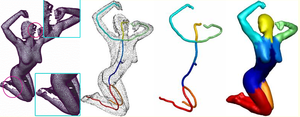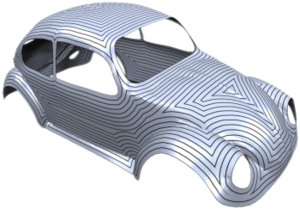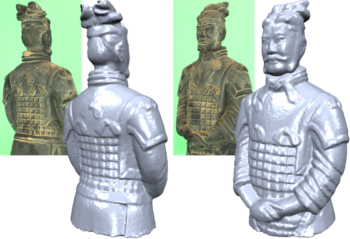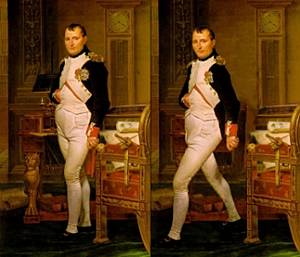Publications
On-the-fly Curve-skeleton Computation for 3D Shapes

The curve-skeleton of a 3D object is an abstract geometrical and topological representation of its 3D shape. It maps the spatial relation of geometrically meaningful parts to a graph structure. Each arc of this graph represents a part of the object with roughly constant diameter or thickness, and approximates its centerline. This makes the curve-skeleton suitable to describe and handle articulated objects such as characters for animation. We present an algorithm to extract such a skeleton on-the-fly, both from point clouds and polygonal meshes. The algorithm is based on a deformable model evolution that captures the object’s volumetric shape. The deformable model involves multiple competing fronts which evolve inside the object in a coarse-to-fine manner. We first track these fronts’ centers, and then merge and filter the resulting arcs to obtain a curve-skeleton of the object. The process inherits the robustness of the reconstruction technique, being able to cope with noisy input, intricate geometry and complex topology. It creates a natural segmentation of the object and computes a center curve for each segment while maintaining a full correspondence between the skeleton and the boundary of the object.
GPU-Based Multiresolution Deformation Using Approximate Normal Field Reconstruction

Multiresolution shape editing performs global deformations while preserving fine surface details by modifying a smooth base surface and reconstructing the modified detailed surface as a normal displacement from it. Since two non-trivial operators (deformation and reconstruction) are involved, the computational complexity can become too high for real-time deformations of complex models. We present an efficient technique for evaluating multiresolution deformations of high-resolution triangle meshes directly on the GPU. By precomputing the deformation functions as well as their gradient information we can map both the deformation and the reconstruction operator to the GPU, which enables us to reconstruct the deformed positions and sufficiently close approximations of the normal vectors in the vertex shader in a single rendering pass. This allows us to render dynamically deforming 3D models several times faster than on the CPU. We demonstrate the application of our technique to two modern multiresolution approaches: one based on (irregular) displaced subdivision surfaces and the other one on volumetric space deformation using radial basis functions.
Accurate Computation of Geodesic Distance Fields for Polygonal Curves on Triangle Meshes

We present an algorithm for the efficient and accurate computation of geodesic distance fields on triangle meshes. We generalize the algorithm originally proposed by Surazhsky et al. . While the original algorithm is able to compute geodesic distances to isolated points on the mesh only, our generalization can handle arbitrary, possibly open, polygons on the mesh to define the zero set of the distance field. Our extensions integrate naturally into the base algorithm and consequently maintain all its nice properties. For most geometry processing algorithms, the exact geodesic distance information is sampled at the mesh vertices and the resulting piecewise linear interpolant is used as an approximation to the true distance field. The quality of this approximation strongly depends on the structure of the mesh and the location of the medial axis of the distance fild. Hence our second contribution is a simple adaptive refinement scheme, which inserts new vertices at critical locations on the mesh such that the final piecewise linear interpolant is guaranteed to be a faithful approximation to the true geodesic distance field.
A Surface-Growing Approach to Multi-View Stereo Reconstruction

We present a new approach to reconstruct the shape of a 3D object or scene from a set of calibrated images. The central idea of our method is to combine the topological flexibility of a point-based geometry representation with the robust reconstruction properties of scene-aligned planar primitives. This can be achieved by approximating the shape with a set of surface elements (surfels) in the form of planar disks which are independently fitted such that their footprint in the input images matches. Instead of using an artificial energy functional to promote the smoothness of the recovered surface during fitting, we use the smoothness assumption only to initialize planar primitives and to check the feasibility of the fitting result. After an initial disk has been found, the recovered region is iteratively expanded by growing further disks in tangent direction. The expansion stops when a disk rotates by more than a given threshold during the fitting step. A global sampling strategy guarantees that eventually the whole surface is covered. Our technique does not depend on a shape prior or silhouette information for the initialization and it can automatically and simultaneously recover the geometry, topology, and visibility information which makes it superior to other state-of-the-art techniques. We demonstrate with several high-quality reconstruction examples that our algorithm performs highly robustly and is tolerant to a wide range of image capture modalities.
Fast Interactive Region of Interest Selection for Volume Visualization

We describe a new method to support the segmentation of a volumetric MRI- or CT-dataset such that only the components selected by the user are displayed by a volume renderer for visual inspection. The goal is to combine the advantages of direct volume rendering (high efficiency and semi-transparent display of internal structures) and indirect volume rendering (well defined surface geometry and topology). Our approach is based on a re-labeling of the input volume's set of isosurfaces which allows the user to peel off the outer layers and to distinguish unconnected voxel components which happen to have the same voxel values. For memory and time efficiency, isosurfaces are never generated explicitly. Instead a second voxel grid is computed which stores a discretization of the new isosurface labels. Hence the masking of unwanted regions as well as the direct volume rendering of the desired regions of interest (ROI) can be implemented on the GPU which enables interactive frame rates even while the user changes the selection of the ROI.
Character Animation from 2D Pictures and 3D Motion Data

This paper presents a new method to animate photos of 2D characters using 3D motion capture data. Given a single image of a person or essentially human-like subject our method transfers the motion of a 3D skeleton onto the subject's 2D shape in image space, generating the impression of a realistic movement. We present robust solutions to reconstruct a projective camera model and a 3D model pose which matches best to the given 2D image. Depending on the reconstructed view, a 2D shape template is selected which enables the proper handling of occlusions. After fitting the template to the character in the input image, it is deformed as-rigid-as-possible by taking the projected 3D motion data into account. Unlike previous work our method thereby correctly handles projective shape distortion. It works for images from arbitrary views and requires only a small amount of user interaction. We present animations of a diverse set of human (and non-human) characters with different types of motions such as walking, jumping, or dancing.
Previous Year (2006)

